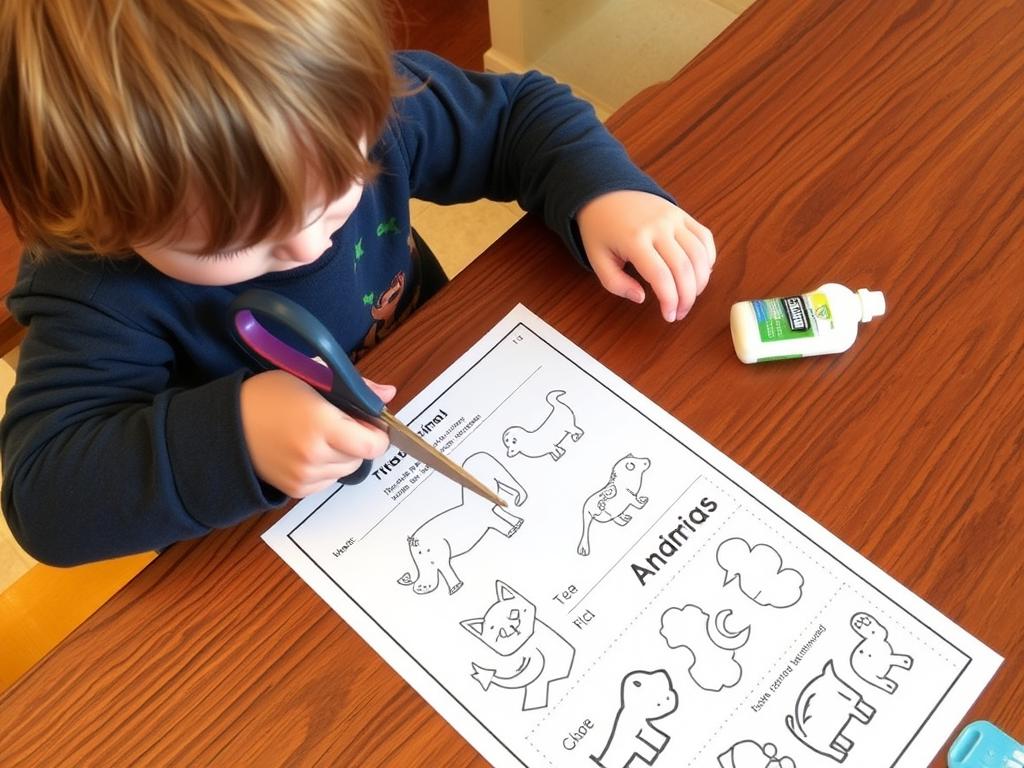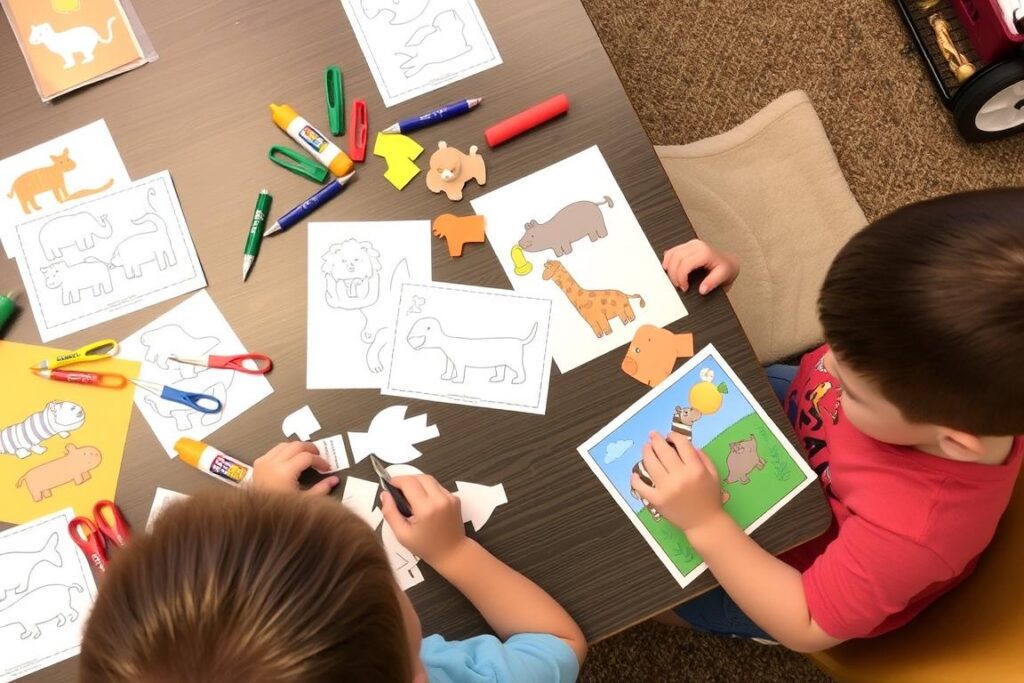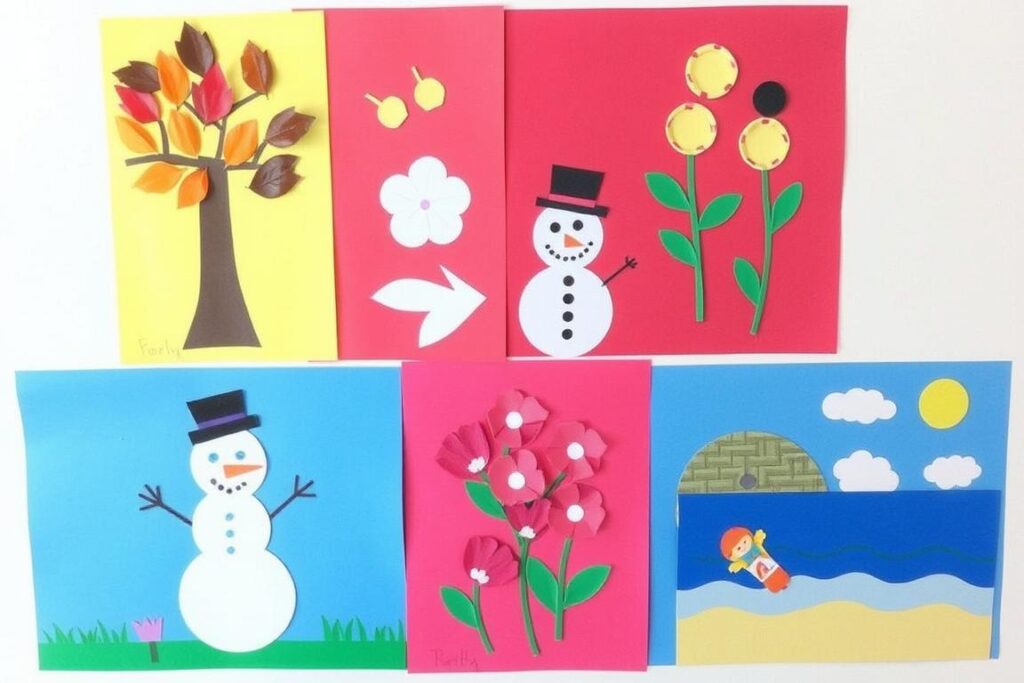Creative Cut and Paste Activities for Kids: Boost Fine Motor Skills & Learning
In this comprehensive guide, we’ll explore age-appropriate cut and paste activities for toddlers through kindergarteners, share themed project ideas, and provide tips for mess-free implementation. You’ll also find free printable resources to get started right away. Let’s dive into the colorful world of cutting, gluing, and creating!
Benefits of Cut and Paste Activities for Early Development
Before diving into specific activities, let’s explore why cut and paste projects are so valuable for young children’s development:
Physical Development Benefits
- Strengthens small hand muscles needed for writing
- Improves hand-eye coordination and bilateral coordination
- Enhances dexterity and precision in finger movements
- Develops proper grip and tool handling skills
- Builds stamina for extended fine motor activities
Cognitive and Educational Benefits
- Reinforces shape, color, letter, and number recognition
- Teaches sequencing, sorting, and categorizing
- Improves visual discrimination and spatial awareness
- Enhances following directions and task completion
- Builds vocabulary and concept understanding
Age-Appropriate Cut and Paste Activities
Children at different developmental stages need appropriately designed activities. Here’s how to tailor cut and paste projects for each age group:
Toddlers (Ages 2-3): First Steps with Scissors
Toddlers are just beginning to develop the coordination needed for cutting. Focus on simple activities with minimal steps:
- Tear and Paste: Before introducing scissors, let toddlers tear paper into pieces and glue them onto a larger sheet to create collages
- Line Cutting: Draw thick, straight lines for them to cut along using safety scissors
- Big Shapes: Provide large, simple shapes with thick outlines for beginning cutters
- Pre-Cut Options: Offer some pre-cut pieces they can arrange and paste independently
Toddler-Friendly Paper Strip Collage
Cut colorful paper into 1-inch strips. Let your toddler practice cutting these strips into smaller pieces (or tear them if scissors are too challenging). Then provide a paper plate or sheet with a simple outline (like a circle or square) where they can glue their pieces.
Preschoolers (Ages 3-5): Building Cutting Confidence

Preschoolers are ready for more complex cutting tasks and can follow multi-step directions:
- Curved Line Cutting: Introduce gentle curves and zig-zags for cutting practice
- Simple Puzzles: Cut pictures into 2-3 pieces for children to reassemble and paste
- Matching Activities: Cut and paste items that go together (like animals to their habitats)
- Letter and Number Recognition: Cut and paste activities that reinforce early literacy and numeracy
Kindergarteners (Ages 5-6): Advanced Cutting Skills

Kindergarteners can handle more intricate cutting tasks and complex instructions:
- Detailed Cutting: Cutting along more complex shapes and smaller patterns
- Sequential Activities: Multi-step projects that tell a story or demonstrate a process
- Academic Integration: Cut and paste activities that reinforce reading, math, and science concepts
- Creative Projects: Open-ended cutting and pasting that encourages design thinking
Math Equation Match-Up
This activity helps kindergarteners practice basic addition and subtraction. Children cut out number cards and equation results, then match and paste them together correctly. It reinforces number recognition, counting skills, and basic operations.
Themed Cut and Paste Activities
Organizing cut and paste activities around themes makes them more engaging and helps reinforce specific concepts. Here are some popular themed ideas:
Animals and Nature

Animal Puzzles
Cut animal pictures into simple puzzle pieces for children to reassemble and paste onto paper. This helps with visual discrimination and part-to-whole relationships.
Habitat Sorting
Cut out various animals and have children paste them in the correct habitat (ocean, forest, farm, etc.). Great for science learning and classification skills.
Life Cycles
Create cut and paste activities showing the life cycles of butterflies, frogs, or plants. Children cut and arrange the stages in the correct sequence.
Seasons and Holidays

Fall Tree
Cut out a tree trunk and have children cut and paste colorful autumn leaves. They can practice cutting curved shapes while learning about seasonal changes.
Holiday Decorations
Create simple ornaments, hearts, shamrocks, or other holiday symbols that children can cut out, decorate, and paste onto cards or displays.
Weather Chart
Make a weekly weather chart where children cut out weather symbols (sun, clouds, rain) and paste them to track daily conditions.
Letters, Numbers, and Shapes

Alphabet Matching
Cut out lowercase letters and have children match and paste them next to their uppercase counterparts. Great for letter recognition and case matching.
Number Sequence
Create number lines with missing numbers that children cut from another sheet and paste in the correct sequence, reinforcing number order.
Shape Sorting
Cut out various shapes and have children sort and paste them by category (circles, squares, triangles) or create pictures using geometric shapes.
Tips for Mess-Free Cut and Paste Success
Cut and paste activities can be wonderfully engaging without creating a huge mess. Here are some practical tips for parents and teachers:
Setup and Materials
- Use Glue Sticks: They’re less messy than liquid glue and easier for small hands to control
- Plastic Trays: Contain scraps and materials within a defined space
- Paper Plates: Perfect disposable work surfaces that catch excess glue
- Pre-Cut Options: For younger children or time-limited sessions, pre-cut some elements
- Washable Materials: Choose washable glue and markers for easy cleanup
Organization and Process
- Clear Instructions: Demonstrate steps before children begin working
- Small Groups: Work with 3-4 children at a time for better supervision
- Designated Spaces: Create “cutting zones” and “gluing zones” to manage materials
- Visual Guides: Provide examples of completed projects
- Clean-As-You-Go: Keep a small trash container nearby for scraps
“I’ve found that using colored paper plates as both work surfaces and for organizing cut pieces has transformed our classroom cut and paste activities. The children stay organized, and cleanup takes minutes instead of half an hour!”
Frequently Asked Questions About Cut and Paste Activities

What age is appropriate to start cut and paste activities?
Children can begin with modified cut and paste activities around age 2, using tear-and-paste techniques before introducing scissors. Most children are ready to use safety scissors with supervision around age 3. Start with simple, straight-line cutting and progress to more complex shapes as their skills develop.
How do I make cut and paste activities educational?
Incorporate learning objectives into your activities: practice letter recognition by cutting and pasting letters to match words, reinforce counting by cutting and pasting the correct number of objects, or teach sequencing by cutting and arranging story elements in order. Always discuss the concepts as children work to reinforce learning.
What are the best scissors for young children?
Look for safety scissors with blunt tips and plastic blades for the youngest children (ages 2-3). For preschoolers (ages 3-5), choose scissors with metal blades but blunt tips and a spring-action to help them open after each cut. For kindergarteners, standard child-sized scissors with a comfortable grip are appropriate. Always supervise children when using scissors.
How can I help a child who struggles with cutting?
Start with thicker paper that provides more resistance and is easier to control. Use adaptive scissors if needed (dual-control scissors let you guide their hands). Practice snipping playdough or straws before moving to paper. Draw thick, bold lines for cutting paths, and consider starting with pre-cut slits that children can continue cutting. Most importantly, be patient and celebrate small successes.
Start Creating with Cut and Paste Activities Today
Cut and paste activities offer a perfect blend of fun, creativity, and learning for young children. By incorporating these activities into your home or classroom routine, you’ll help children develop essential fine motor skills while reinforcing important educational concepts. From simple tearing and pasting for toddlers to complex themed projects for kindergarteners, there’s a cut and paste activity for every age and skill level.
Remember to start with age-appropriate materials, provide clear guidance, and create a supportive environment where children can develop at their own pace. With the printable resources provided in this guide, you’re well-equipped to begin your cut and paste journey right away!

Adam Peter is a finance, travel, and automotive writer with over a decade of experience. He creates clear, practical content to help readers manage their money, explore the world with confidence, and make informed decisions about cars and travel gear. His work blends expert insight with real-world usefulness.



